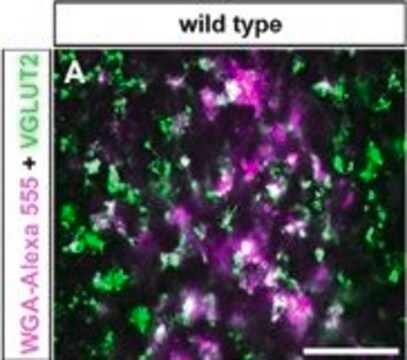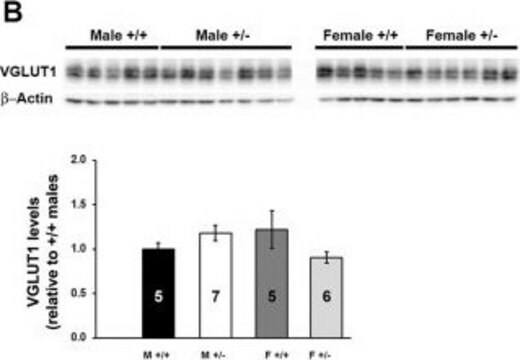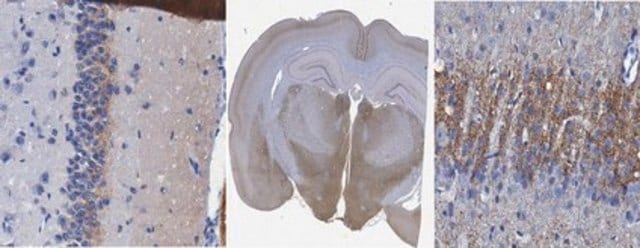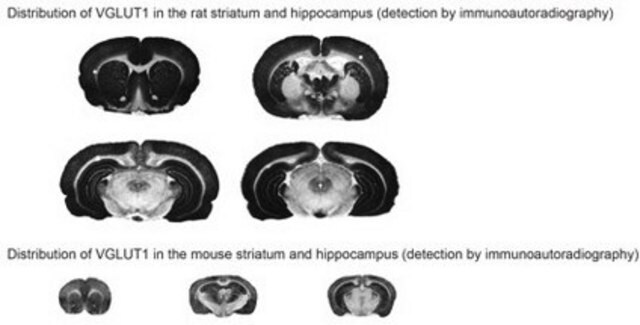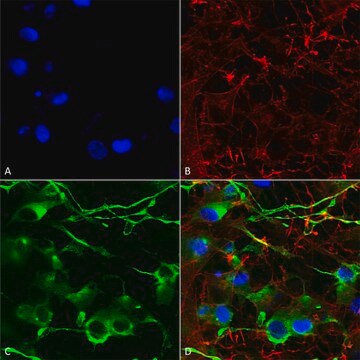AG208
Vesicular Glutamate Transporter 1, control peptide for AB5905
Synonym(s):
VGLUT1, BNPI
Sign Into View Organizational & Contract Pricing
All Photos(1)
About This Item
UNSPSC Code:
12352203
eCl@ss:
32160702
Recommended Products
General description
Synthetic peptide from rat VGLUT1 protein.
VGLUT1 is expressed in a subset of glutamate neurons and transports glutamate into native synaptic vesicles from the brain, exhibiting a conductance for chloride that is blocked by glutamate. Vesicular glutamate transport has a substantially lower apparent affinity than the plasma membrane excitatory amino acid transporters. Glutamate transport by VGLUT1 is saturated with a K(m) of approximately 2 mM, in the same range as transport by synaptic vesicles. Finally, plasma membrane glutamate transporters recognize both aspartate and glutamate as substrates, whereas VGLUT1 does not recognize aspartate.
Application
For use in blocking the reactivity of AB5905.
Optimal working dilution must be determined by the end user.
Optimal working dilution must be determined by the end user.
Legal Information
CHEMICON is a registered trademark of Merck KGaA, Darmstadt, Germany
Storage Class Code
12 - Non Combustible Liquids
WGK
nwg
Flash Point(F)
Not applicable
Flash Point(C)
Not applicable
Certificates of Analysis (COA)
Search for Certificates of Analysis (COA) by entering the products Lot/Batch Number. Lot and Batch Numbers can be found on a product’s label following the words ‘Lot’ or ‘Batch’.
Already Own This Product?
Find documentation for the products that you have recently purchased in the Document Library.
Synaptotagmins I and II in the developing rat auditory brainstem: Synaptotagmin I is transiently expressed in glutamate-releasing immature inhibitory terminals.
Alan P Cooper,Deda C Gillespie
The Journal of Comparative Neurology null
VGLUT1 and VGLUT2 innervation in autonomic regions of intact and transected rat spinal cord.
Ida J Llewellyn-Smith,Carolyn L Martin,Natalie M Fenwick,Stephen E Dicarlo,Heidi L Lujan et al.
The Journal of Comparative Neurology null
Ramon Guirado et al.
Heliyon, 4(6), e00669-e00669 (2018-07-14)
The quantification of the expression of different molecules is a key question in both basic and applied sciences. While protein quantification through molecular techniques leads to the loss of spatial information and resolution, immunohistochemistry is usually associated with time-consuming image
Seth L Shipman et al.
Proceedings of the National Academy of Sciences of the United States of America, 109(47), 19432-19437 (2012-11-07)
The transsynaptic complex of neuroligin (NLGN) and neurexin forms a physical connection between pre- and postsynaptic neurons that occurs early in the course of new synapse assembly. Both neuroligin and neurexin have, indeed, been proposed to exhibit active, instructive roles
Alain C Burette et al.
The Journal of comparative neurology, 512(4), 500-513 (2008-11-26)
The plasma membrane Ca(2+)-ATPases (PMCA) represent the major high-affinity Ca(2+) extrusion system in the brain. PMCAs comprise four isoforms and over 20 splice variants. Their different functional properties may permit different PMCA splice variants to accommodate different kinds of local
Our team of scientists has experience in all areas of research including Life Science, Material Science, Chemical Synthesis, Chromatography, Analytical and many others.
Contact Technical Service